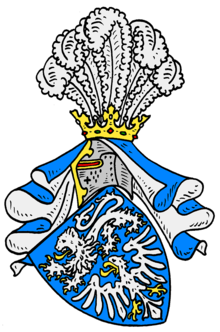- Counts of Andechs
-
The House of Andechs was a feudal line of German princes in 12th and 13th century. The Counts of Dießen-Andechs (~1100 to 1180) obtained territiories in northern Dalmatia on the Adriatic seacoast, where they became Margraves of Istria and ultimately Dukes of a short-lived Imperial State named Merania from 1180 to 1248.
The noble family originally resided in southwestern Bavaria at the castle of Ambras near Innsbruck, controlling the road to the March of Verona across the Brenner Pass, at Dießen am Ammersee and Wolfratshausen. One Count Rasso (Rath) is documented in Dießen, who allegedly fought against the invading Magyars in the early 10th century and established the monastery of Grafrath. By their ancestor Count Palatine Berthold of Reisensburg, a grandson of the Bavarian duke Arnulf the Bad, the Andechser may be affiliated with the Luitpolding dynasty. Berthold appears a fierce enemy of King Otto I of Germany and was blamed as a traitor at the 955 Battle of Lechfeld against the Hungarians. He probably married a daughter of Duke Frederick I of Upper Lorraine; his descendant Count Berthold II (d. 1151), from about 1100 residing at Andechs, is credited as the progenitor of the comital dynasty.
Berthold II had inherited the family's Bavarian territories, but also acquired possessions in the adjacent Franconian region, where about 1135 he had the Plassenburg built near Bayreuth and established the town of Kulmbach. He served as vogt of Benediktbeuern Abbey and by marriage with Sophie, daughter of Margrave Poppo II, came into property of lands in the March of Istria and Carniola.
Otto II of Andechs was bishop of Bamberg in 1177–1196. In 1208, when Philip of Swabia, King of the Germans, was assassinated at Bamberg by Otto of Wittelsbach, members of the house of Andechs were implicated.
Saint Hedwig of Andechs (c. 1174 – October 1243) was one of eight children born to Berthold IV, Duke of Merania, Count of Dießen-Andechs and Margrave of Istria. Of her four brothers, two became bishops, Ekbert of Bamberg (1203 – 1231), and Berthold, Patriarch of Aquileia.
Otto succeeded his father as Duke of Dalmatia, and Heinrich became Margrave of Istria. Of her three sisters, Gertrude of Andechs-Merania (1185–September 24, 1213) was the first wife of Andrew II of Hungary and the mother of St Elizabeth of Hungary; Mechtilde became Abbess of Kitzingen; while Agnes, a famous beauty, was made the illegitimate third wife of Philip II of France in 1196, on the repudiation of his lawful wife, Ingeborg, but was dismissed in 1200, after Pope Innocent III laid France under an interdict.
The dukes of Merania went extinct in the direct male line in 1248. A history of the house of Andechs was written by Joseph Hormayr Freiherr zu Hortenburg, the historian-statesman, and published in 1796.
External links
Categories:- Countships of Germany
- House of Andechs
Wikimedia Foundation. 2010.


